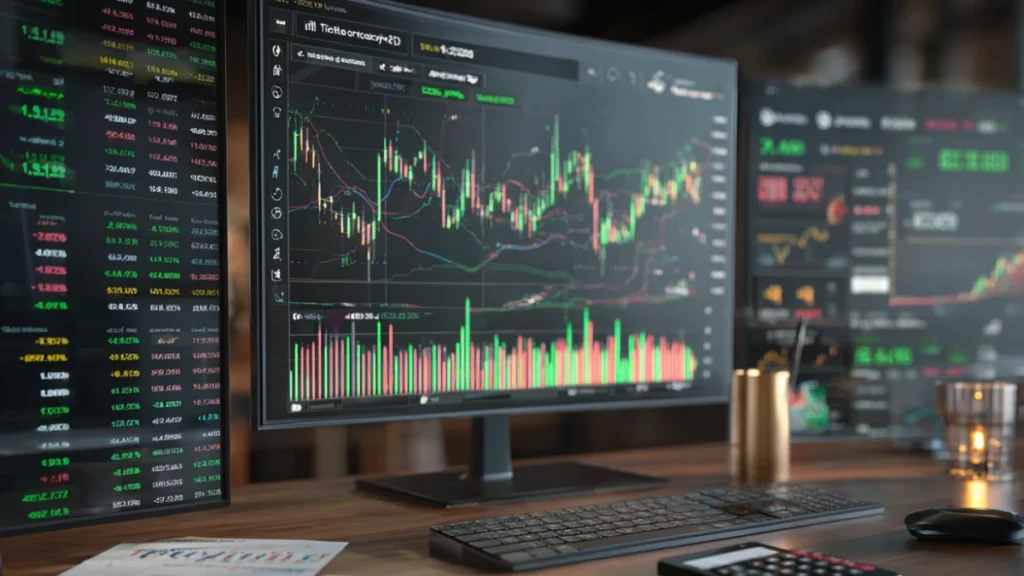Table of Contents
Introduction:
If you’ve ever jumped into a trade based on gut feeling, random alerts, or the hype of the moment — you’re not alone. Most beginners enter the market with energy, ambition, and zero structure. And that’s exactly why they lose.
A trading plan is your personal blueprint. It defines how you trade, when you trade, what you trade, and why you trade. More importantly, it keeps you grounded — so you’re not chasing candles, forcing setups, or spiraling after a loss.
At Mastery Trader Academy, we believe that mindset and structure matter more than the latest indicators. That’s why we recommend every trader — especially those using prop firm capital — create a simple, repeatable plan they can follow under pressure.
In this guide, you’ll learn:
• Why trading without a plan is like gambling with better graphics
• The 7 key components every good trading plan must include
• Real-world examples from funded traders who stick to their system
• How to create a plan that matches your lifestyle, psychology, and goals
This isn’t about making trading complicated. It’s about making it yours — and turning chaos into clarity, one trade at a time.

❌ Why Most Traders Fail Without a Plan
Imagine showing up to a battlefield with no strategy, no map, and no exit route — just vibes. That’s what it’s like trading without a plan. And it’s why most retail traders blow their accounts, especially during their first year.
Here’s what happens without a trading plan:
• Emotional trading takes over
Without clear rules, you start chasing losses, getting greedy, and acting on fear instead of logic.
• Inconsistent results become the norm
One day you scalp gold. The next, you swing trade crypto. No consistency = no edge.
• Risk becomes random
Some trades risk 1%. Others risk 10%. You don’t grow — you gamble.
• You blame the strategy, not the lack of structure
Most beginners don’t fail because their strategy is bad — they fail because they never followed one properly.
At Mastery Trader Academy, we’ve seen funded traders succeed not because they’re geniuses — but because they stick to a boring, disciplined plan. Especially with prop firms, where consistency and risk control are everything.
Would you like to continue with:
- ✅ The 7 Core Elements of a Trading Plan
- 📋 Real Example: What a Simple Trading Plan Looks Like
- 🧠 How to Stick to Your Plan When You’re Emotional
✅ The 7 Core Elements of a Trading Plan
Creating a trading plan isn’t about adding more complexity — it’s about building a clear system that fits your personality, goals, and market approach. Every consistent trader you admire has one thing in common: structure.
Here are the 7 essential components your trading plan must include:
- 🎯 Trading Goals
Your goals define your direction.
• Are you trading to build long-term wealth or generate daily income?
• Do you want to pass prop firm challenges or trade your own capital?
• How many trades per week? What’s your monthly profit target?
Set SMART goals — Specific, Measurable, Achievable, Relevant, Time-bound — and break them into milestones.
🔑 Example: “My goal is to earn $2,000/month using a funded account within 6 months while keeping drawdown under 5%.”
- 🕰 Trading Sessions & Schedule
You can’t trade 24/7. Define your active trading hours based on your lifestyle and market.
• Best times to trade (e.g., London session for Gold, NY open for indices)
• How many hours/day and days/week you commit
• When you review or journal your trades
🔑 Tip: Consistency in your trading hours builds discipline and helps you understand market rhythms.
- 📊 Markets & Instruments
You don’t need to trade everything. In fact, you shouldn’t.
• Choose 1–3 markets to master (e.g., Gold, CL, NAS100)
• Avoid switching pairs or chasing volatility
• Know your instrument’s behavior, volatility, and news cycles
🔑 Example: “I only trade GC (Gold Futures) during the London and NY overlap, using range charts and HTF FVGs for entries.”
- 🧠 Strategy & Setup Criteria
This is the heart of your plan. Your edge.
• What structure or patterns do you trade?
• What confirms your entry? (e.g., volume, order flow, EMA crossover)
• When do you avoid trading? (chop, news, no FVGs, etc.)
🔑 Note: Keep it simple. Focus on 1–2 setups you can repeat 100 times with discipline.
- 📉 Risk Management Rules
No edge survives without risk control.
• How much do you risk per trade? (e.g., 1% of capital)
• Daily loss limit? (e.g., max $300/day)
• Position sizing strategy?
🔑 Tip: If you’re using a prop firm like Apex or FTMO, following their drawdown rules is non-negotiable.
- 🚪 Exit Strategy
Knowing when to exit is just as important as when to enter.
• Where do you place your stop-loss and take-profit?
• Do you trail stops based on structure or exit on flow reversal?
• Do you scale in or out?
🔑 Example: “I exit my GC trade when opposing volume and energy appear on the 19R chart, or at the next 4H FVG.”
- 📘 Trade Review & Improvement System
No plan is complete without feedback loops.
• Do you journal trades daily or weekly?
• What metrics do you track? (e.g., win rate, R:R, emotional mistakes)
• How often do you review and refine your plan?
🔑 Tip: Use tools like TradeZella, Notion, or a simple spreadsheet. Without review, you’ll keep repeating the same mistakes.
When you combine all 7 components, you stop trading on guesswork and start operating like a professional. Your plan becomes your trading GPS — keeping you calm, focused, and profitable.
📋 Real Example: What a Simple Trading Plan Looks Like
Let’s face it — trading advice can feel vague until you see how it actually works in real life.
That’s why we’ve created a simple sample trading plan based on what successful traders do. This is a model any beginner can follow and adjust to fit their own personality, lifestyle, and goals.
👤 Sample Trader Profile
• Experience: Beginner to intermediate
• Account Type: Demo, personal capital, or funded account
• Style: Intraday (short-term trades)
• Markets Traded: Gold (GC), Crude Oil (CL), or NAS100
• Main Tools: Price action, key levels, simple indicators
✅ Example Trading Plan Template
- Trading Goals
• Earn 5–10% monthly while protecting capital
• Limit drawdown to under 5%
• Build consistency, not chase wins
• Pass funded account evaluations over the next 3 months
- Trading Schedule
• Trade during peak sessions only (e.g., NY open or London session)
• Max 2–3 trades per day
• Daily review at the end of each session (journal trades, track mistakes)
- Markets to Trade
• Stick to 1–2 instruments (e.g., Gold, CL, NAS100)
• Avoid jumping to new pairs every week
• Master the behavior of those specific markets
- Strategy & Setups
• Trade only specific setups (e.g., breakout + retest, support/resistance bounce)
• Use confluences like market structure, volume spikes, or trend indicators
• Avoid trading in chop or before major news
- Risk Management
• Risk 1% of account per trade
• Max daily loss limit = 2%
• Stop-loss and take-profit always predefined
• No revenge trading after a loss
- Exit Rules
• Exit at next major level or once price shows rejection
• Use trailing stop if in profit
• Accept small wins over emotional holding
- Trade Review System
• Use a journal (spreadsheet, Notion, or apps like TradeZella)
• Track win rate, setups, emotions, mistakes
• Weekly self-review to adjust and improve
✍️ Final Thoughts
This is not a “perfect” plan — it’s a working base.
You don’t need advanced tools or fancy setups to succeed. What matters is clarity, consistency, and discipline. A simple, repeatable trading plan gives you structure so you can show up like a pro, even when your emotions try to take over.
🧠 How to Stick to Your Plan When You’re Emotional
You could have the perfect trading strategy, risk management rules, and detailed journal — and still blow up your account… if you let emotions take control.
Let’s be honest — the hardest part of trading isn’t learning charts. It’s sticking to your plan when the pressure is on.
Here’s how to stay calm, disciplined, and focused — especially during those moments when everything inside you wants to break the rules.
- 🧯 Recognize Your Triggers
Most traders lose discipline because they don’t recognize their emotional triggers until it’s too late.
• Do you feel panicked after a losing streak?
• Do you get greedy after one big win?
• Do you chase trades when you’re bored?
🔑 Pro tip: Keep a simple “Emotional Log” next to your journal. Track what triggered you before and during trades.
- 🧘 Build a Pre-Trade Routine
Just like athletes have warm-ups, traders need routines to switch into a focused mindset.
A good pre-trade checklist might include:
• Reviewing your trading plan
• Marking key levels/zones
• Breathing deeply for 1 minute
• Repeating an affirmation like: “I only take trades that match my setup. I don’t chase.”
This small habit can prevent impulsive trades that destroy your day.
- ⏸ Use the “Pause Before Entry” Rule
If you’re feeling anxious, excited, or pressured — pause for 60 seconds before entering any trade. Ask yourself:
• Does this trade follow my plan?
• Is the setup valid and confirmed?
• Am I entering from logic or emotion?
🔒 If it doesn’t meet your checklist, you don’t trade. Simple as that.
- 🧠 Detach from the Outcome
The goal of trading is not to win every trade. It’s to execute your edge with consistency over time.
Once you’ve entered a trade:
• Don’t watch every tick
• Trust your stop loss and take profit
• Let the system work — your job is already done
🎯 Win or lose, if you followed your plan, it was a good trade.
- 📕 Journal Your Emotional Mistakes
Tracking emotional decisions is more valuable than tracking just win/loss.
In your post-trade notes, write:
• What you felt before the trade
• Whether you followed your rules
• What you’ll do differently next time
Over time, this builds self-awareness — your strongest weapon against sabotage.
- 👥 Build Accountability
If you struggle to stay disciplined alone:
• Join a trading group or community
• Share your goals and daily limits
• Review your week with someone who understands trading
At Mastery Trader Academy, we’ve seen beginners transform just by having someone to check in with.
🧩 Final Words: Mastering Your Mindset = Mastering the Markets
The best trading plan means nothing if you can’t follow it. Emotional discipline is the glue that holds your system together.
You don’t need to be a robot. But you do need structure, awareness, and self-control — especially when the pressure is high.
Every consistent trader learned how to stay calm in chaos. And now you’re one step closer to doing the same.
✅ Recap:
• Your trading plan is your blueprint
• Following it under pressure takes awareness, not perfection
• The more emotional control you develop, the more consistent you become
Creating a consistent trading routine begins with having a structured system that balances clarity, risk control, and emotional discipline. While countless strategies promise quick profits, most traders fail simply because they lack a clear plan and mindset framework. According to CME Group’s official trader education hub, understanding how futures markets operate — from contract specs to margin mechanics — is essential before risking real capital. However, mastering the technicals is only part of the equation.
At Mastery Trader Academy, we emphasize combining market knowledge with psychological control, especially in high-volatility environments like Gold or Crude Oil. If you’re still developing your structure, start by reading our in-depth guide on the Liquidity Inducement Trading Strategy: How Smart Money Lures Retail Traders Into the Trap. This will help you identify how institutional players manipulate price, and how you can build your rules around those behaviors. By combining proper market education with internal discipline, traders are far more likely to avoid retail traps, maintain consistency, and pass even the toughest prop firm evaluations.

